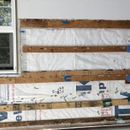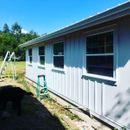Moisture related problem – rainscreen
Zone 4c
3/4” furring strips untreated CDX, Coravent at bottom, w/ air gap at the top. If any other relevant indiscernible details please ask for clarification.
I recently had to take down a few Sheets of hardiepanel in order to do a minor change of something I changed my mind on. After pulling a few sheets down that had been up for about a year now, I noticed that the closer the to the corner, or other edge of my completed work, the more the CDX had dark speckles (mold spores?) on them (see pictures) as well as faint, but still dark speckles in a good number of places where my stainless siding nails penetrated through.
this was not a completed job as I left my corner trim off – heaviest amount of darkness – and have not caulked any seams anywhere.
please, I want to know if there is something wrong with my system…
if I need to allow these particular furring pieces on the edges to dry out before replacing or if this is to all be expected given it was left for a full season without even being covered in some places?
specifically looking for advice on how to deal with or what is necessary in the future here af far as sealing moisture out:
1) is it a good idea to fill all siding nail holes even though they are or will eventually be covered by batten trim pieces (see image of final design)?
2) And/or is it a good idea to caulk each vertical batten trim piece and corner trim? (I was under the impression this wasn’t really necessary as my system is self drying and there’s no where for water to pool)
Any other advice? thank you!
GBA Detail Library
A collection of one thousand construction details organized by climate and house part












Replies
Anyone have any thoughts? Sorry if the pictures are hard to decipher, they are rotated sideways on my end at least.
Nothing blocks bottom to top airflow? Slightly angle nails? Maybe replace with treated wood?
Thanks Jon, no, no blockage of the venting. Angled nails that’s interesting didn’t think of that. You saying it would be ideal to nail slightly upward?
Looks like Hardie calls for snug (not flush) and level nails. But the furring nails might benefit.
Kevin,
I don't see much to worry about.
The furring is best attached with galvanized nails, but I doubt the commons will develop more than surface rust.
A bit of discolouration is to be expected. The battens should be fine without caulking.
Get it finished, get some paint on it.
Thanks Malcolm, and for the record I did use coated decking screws to attach furring, and galv framing nails.. so a combination.
As far as the actual panel siding fastening, I’m thinking the other gent may be right or at least on the right track because in hardie instructions they say if a nail is depressed upon fastening to then fill in the dimple and re-nail a few inches away.
(To be clear, it wasn’t the furring strips’ fasteners that had the water spots, it was where the (stainless) siding nails had penetrated.)
Probably the concern here with hardie is that ‘countersunk’ siding nails not holding well, but that it also creates a place for water to be trapped. I think I will caulk over at least the Incorrectly driven countersunk siding nails, if not all of the nails on the panels just to be extra safe here. Doesn’t bother me and will give peace of mind.